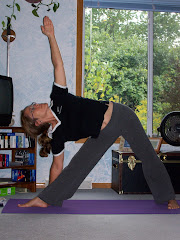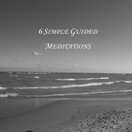
Being a student of Hatha Yoga for many years now, I figured it was time I read the Hatha Yoga Pradipika. Whenever I'm at a workshop and the teacher mentions something from this text, I sit quietly feeling a bit guilty for not having read it.
So, finally I decided to get Brian Akers translation and see what it was all about. The Pradipika was written in the 1400's and the title means to shed light on the subject of Hatha Yoga.
The first chapter covers Asanas. There are 15 of them--none of them standing. It seems to me that in this day and age of cars, chairs, telephones, and TVs, Yoga had to add many other postures, including standing ones, so that people could comfortably do some of the postures in the Pradipika. Even simply sitting on the floor for any length of time requires flexibility, especially in the back body. I wonder how many people in the 1400's had back problems?
Chapter two is on Pranayama, which is recommended to only begin after mastering Asana. Even today there are teachers that say you need to wait to start Pranayama and others that talk about it the first day of class. I think the confusion has to do with what you define at Pranayama. Noticing your breath's qualities and length and using some Ujjayi breathing are quite innocent and (in my opinion) worthy of learning early on in a practice. Adding in the bandhas with full breath retention takes more finesse and awareness. Asanas is a great way to attain the subtle awareness needed for proper Pranayama.
Next is chapter three on Mudras. To be honest, when I think of Mudras, I think of Hand Mudras. The Pradipika talks more about full body Mudras. There are some useful tips for Mahamudra--a more advanced technique. Such as placing the "the tongue on the front teeth....This obstructs the upward motion of all the nadis."
I really had to let a lot slide, especially in this chapter. For example:
"As a beautiful and charming woman without a man, so Mahamudra and Mahabandha are pointless without Mahavedha." [Pointless without a man? Women's lib must not have been around.]
"Turn the tongue backward and insert it into the skull cavity." [Ah, so that's how to scratch the inside of the brain!]
"Gradually elongate the tongue by cutting, shaking, and stretching it until it touches the middle of the brows." [Did people really do this stuff??]
"Mix the lunar nectar released by this practice with cow-dung ashes and smear one's important parts. Divine insight is born." [Do not try this at home!!]
The forth, and final chapter, addresses Samadhi or merging with a single object. I found it to be a relatively esoteric description of how to meditate. There are some ideas on where and how to place the inner gaze. Being a practical gal, I would select a more modern day book on meditation if I was looking for guidance. Better yet, I'd find a teacher.
In summary, I can now listen to teachers reference one of the first books (if not the very first) on Hatha Yoga without feeling bouts of guilt. I'm glad I read it. I feel more well-rounded and a little more knowledgeable in the history of Yoga. I wouldn't recommend it for a beginner in Hatha Yoga--or the smearing of the cow dung might make them run for the hills!
I promise you can effectively practice Hatha Yoga without having to cut your tongue or find a good man.
Love Much,
Kris
http://www.totalhealthyoga.com/
http://www.learnyogaonline.blogspot.com/
Today is the first day of the rest of your life!
Kris
http://www.totalhealthyoga.com/
http://www.learnyogaonline.blogspot.com/
Today is the first day of the rest of your life!



2 comments:
LOL great post hon!
I find it a little hard to read the older books for some of the very reasons you have mentioned. It's great to know where yoga has come from though and be open minded about the way the older texts have been written in the time like you have shown. I hope to find the time to read some of them soon.
I do tend to focus on more updated material for my reference though, especially when concerning anatomy. And listen to my teachers of course who are a wealth of knowledge themselves :-)
Sorry, I was laughing because of the reference to cow dung. My teacher was telling me about some of the stories David Life shared on their teacher training recently. I think I'll stick with using my mat ;-)
Post a Comment